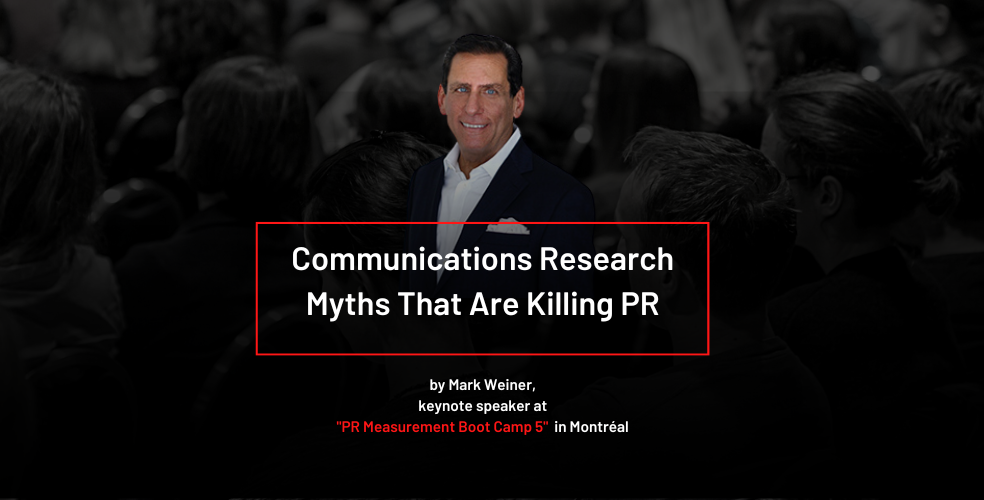 November 24, 2022
November 24, 2022

Communications Research Myths That Are Killing PR
January 18, 2023
by Mark Weiner, keynote speaker at the "PR Measurement Boot Camp 5" in Montréal
While the Greeks looked to Mount Olympus to explain the laws of nature, other myths throughout history have been used to protect the vested interests of a select group. In both cases, myths help to explain and bring order to the sometimes-chaotic world of everyday life.
Like many cultures, the Public Relations profession adheres to a unique catalogue of mythology. And like all mythologies, PR’s mythology breaks down severely when planning, decision-making and performance evaluation take place without the benefit of facts, truth and even common sense.
This essay seeks to shed light on the “conventional wisdom” that holds us back and to dispel the myths of public relations. Given the task, it’s only appropriate that we begin at the beginning with “the myths of PR objectives-setting.”
Five Common Myths to Avoid in Communication Research
1. PR MYTH: It's better to set objectives quickly so the campaign can launch rather than wait, do the research, and seek to build consensus
PR TRUTH: While today’s business climate requires speed, setting objectives without consensus is a risky proposition. Clear, concise objectives upon which key internal and external clients agree are the key to proving value and minimizing risk. The fallacy is rooted in the false belief that consensus must be time-consuming and laborious.
Consensus-building becomes simpler and more efficient when the priorities of the organization and the preferences of key executives are known in advance. One approach is the annual “executive audit” which helps to align overall objectives prior to the launch of an individual campaign. Based on a solid foundation, campaign-specific objectives become an exercise in incremental adjustment rather than “starting from scratch.”
2. PR MYTH: A good way to set objectives is to track your competition and set your goals based on their performance.
PR TRUTH:Tracking competitive performance can be a great source of insight by analyzing relative strengths and weaknesses in terms of message delivery, media receptivity and more. But as a basis for setting objectives, don’t assume that your competitors have the same resources as you do; that their objectives, business priorities and timetable are the same as yours; and, well, that they even know what they’re doing to begin with!
A more reliable approach is to begin with a clean slate: determine which objectives are reasonable, meaningful and measurable for you: use your competition as one of several reality-checks which may include your own “internal clients” whose opinions will contribute to overall planning, resource allocation and evaluation; your peers in marketing and communication whose plans may help to elevate or handicap your own plans; and a research-based marketplace assessment to ensure that your plans are free from assumptions, guesswork and erroneous conclusions.
3. PR MYTH: PR research is too expensive and complicated for smaller organizations
PR TRUTH: Nope. Not true. PR research is for any public relations professional who seeks to prove PR value and improve PR performance. Actually, PR research was never out of reach for most communications organizations…even small ones! Yes, there is a trade off with low-cost solutions, but I’d rather be approximately right than totally in the dark. However, there are situations where more evolved research is required, especially for advanced analytics and consulting around predictive analytics and analysis to make the PR-to-Sales connection. For media analysis and surveys, international programs will be more expensive. For media analysis, complex technical reading and coding is time consuming for human analysts, so it costs more than a domestic program tracking “Coke vs. Pepsi.”
When shopping for communications research, you should specify your objectives and the scope of the public relations program you’re running. Better communications research providers make it easy to get to the essence of your need to help you meet your need. Scope drives price and complexity but it need not be out of reach for any communicator. As you consider your options, remember the axiom, “Low Cost. Speed. Accuracy. Pick two.”
4. PR MYTH: Your budget determines your value
PR TRUTH: Nonsense. While it’s true that public relations budgets are tiny when compared to other channels in the marketing and communications mix, we in PR can take pride our ability to do more for less and with less. Just like anyone else within the enterprise, PR strives to deliver a positive return-on-investment. And ROI should be the determinant. One reason why PR delivers such outsized returns is that PR budgets are relatively minimal. When the low levels of investment are combined with PR’s extraordinarily slow decay rate, the combination sets the stage for the greatest efficiency among all marketing and communications channels. Marketing Mix Models are an advanced statistical analysis that reveals and isolates the impact of each channel. The models are still rare for PR people to do in isolation but other teams within the organization may be conducting them and these data scientists yearn for additional data streams to help explain the ups and downs of marketing performance. Look for people with titles like “consumer insights” as well as market research…they need to know you!
Your true value will be determined when you quantify PR’s returns versus others. The results will astound the C-Suite, the Board of Directors, and even the marketers. The experiences of those who incorporate PR data into marketing mix models end in budget increases. In one personal experience for a brand whose name you’d recognize, the budget increased 800%! The head of communications couldn’t find a defensible way to spend it, so he gave half of the budget back!
If you read this far, you already hold an interest in learning more about the importance of research in public relations: it helps to optimize success, mitigate failure, and ensure that your message resonates with the people with whom you seek to relate.
But for every PR practitioner who believes in the promise of research-driven communication, there are many more for whom it does not.
*
Mark Weiner is a research-based consultant whose devoted his career to elevating the power public relations. He is the author of two books named among BookAuthority.com’s Top 50 PR Books in History.” His latest book, entitled “PR Technology, Data and Insights” was published in 2021 by Kogan Page. Mark is a board member for the Institute for Public Relations who awarded him its Jack Felton Award for Lifetime Achievement in 2018. He is a member of the Arthur Page Society and an advisor to the University of Florida’s School of Communication and Journalism.
He is speaking next at our “PR Measurement Boot Camp 5”, from 23-24 March in Montréal.
Click here to get your early-bird ticket and SAVE C$300!